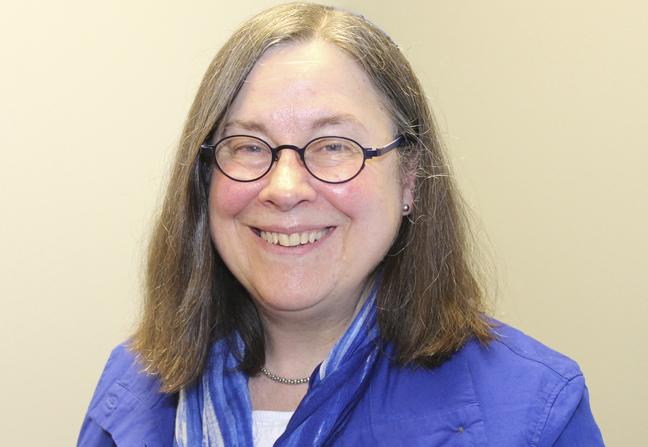A year of taking stock for Temple Israel

By Marshall Weiss, The Dayton Jewish Observer
A dozen years ago, Rabbi Ilene Bogosian was one of three rabbis sent to congregations to test out the Reform movement’s interim ministry pilot project.
Now she is one of 16 interim rabbis in a well-established program coordinated through the placement service of the Central Conference of American Rabbis.
Each year, she serves a different Reform congregation in North America.
“There are times when I think we shouldn’t call it interim,” Bogosian says. “The whole thing is about transition and transformation.”
The Watertown, Mass. resident arrived here from her most recent interim post in Mississauga, Ontario. She’ll serve Temple Israel through June 2016, while the congregation conducts the search for its next senior rabbi.
“It’s an in-between point,” she says of her year ahead with the 165-year old temple.
Sometimes she’s used the term cheshbon hanefesh, an accounting of souls, to frame a congregation’s work over the interim year.
“There’s so much potential in stopping: looking around at where you are as a community, taking time to pause, maybe experiment a little bit,” she says. “Also taking time to mourn what’s passed, or celebrate how they felt about the previous rabbi.”
The rabbinate is Bogosian’s second career. A native of New Jersey, she was first a psychiatric social worker with a specialty in family systems therapy.
After her ordination in 1992 at Hebrew Union College-Jewish Institute of Religion in Cincinnati, she became a college campus rabbi.
When her husband began thinking about retirement, she contacted the rabbinic placement director at CCAR about other rabbinic career opportunities. He suggested she consider becoming an interim rabbi because of her background in family systems theory.
One of the first congregations she served as interim rabbi — within driving distance of her home in Boston — saw its beloved rabbi depart because the rabbi’s husband couldn’t find employment in the region.
“It was very difficult, a crisis for the congregation,” Bogosian said.
“One of the big items of feedback was that I served as a calm point in an emotional storm for them about losing their rabbi.”
She describes Temple Israel’s situation as much more positive.
“This is an anticipated retirement and an interim is part of the plan.”
Bogosian says interim rabbis tend to be empty nesters; her two sons are grown up and out on their own.
“You can’t do this with children growing up,” she says. “Interim rabbis are either childless or toward the end of their career, or they’re in the middle of a career and not sure where to go next.”
Her excitement comes from meeting new people in her posts, and helping congregations wrestle with their particular challenges.
“It’s fascinating to me how alike we all are as Jews — it’s fascinating to me how unique each community is, each individual. There are themes and challenges that repeat, but never entirely in the same form.
“I’m not a consultant. I don’t come in and tell you what to do to fix whatever. I’m of the opinion that stuff gets ignored anyway. I’m here to point out that you’re up against this challenge, and I’ve served in three other congregations that had a similar challenge. These were the solutions they developed. Your situation is unique to you. What do you think you might do?”
Part of Bogosian’s role, she says, is to serve as a lightning rod for whatever controversies are present in the congregation.
“I’d much rather have people annoyed with Rabbi Bogosian for whatever it is than the brand-new rabbi walking in the door,” she says.
She’ll also help Temple Israel prioritize the most important attributes it seeks for its next senior rabbi.
“I do not comment on the candidates. And I have no role in the decision, only the process of finding the right candidates. It’s about helping them (the temple) know how to go about doing this in the right way.”
After one of Bogosian’s first meetings with members, one Temple Israel congregant told her, “Well, I was really against this because I just really thought you were going to be a fill-in. Now I see there’s a lot more to it.”
“It’s all about presence — being present for people,” Bogosian says. “People really need to feel there’s someone there they can really rely on to support them through whatever life hands them during this year, personally or congregationally.”
To read the complete August 2015 Dayton Jewish Observer, click here.

